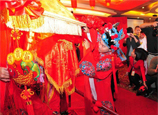
 |
| Gingko trees at Huayuan Lane (Shanghai Daily) |
Gingko trees @ Huayuan Lane and Yangjia Village
At more than 100 meters, Huayuan Lane between Chaohui Park and a small river is a great place for a walk and taking photographs, as some 300 gingko trees fringing the path turn gold in late autumn.
For a perfect autumn walk, take a stroll down the sun-dappled path, your feet scrunching among fallen leaves with all their mottled shades. And gazing at the crowns of the trees, with their lemon yellow leaves against a clear blue sky, will surely warm your heart against any winter chill.
Yangjia Village is at the junction of Fuyang, Lin'an and Tonglu, and boasts thousands of gingko trees extending several kilometers, creating a scene at once idyllic and magnificent.
The village is composed of many smaller hamlets, and the trees are not planted in lines, but grow naturally between farmers' houses, their yellow tones creating a serene landscape.
Gingko grows slowly; in Chinese it is known as the "grandpa-and-grandson tree," which means that a man may plant the tree while young, yet will only see it bear fruit when he is old enough to have a grandson.
The tree needs at least 20 years to fruit, and in Yangjia Village the tradition of growing gingko started 500 years ago. Today, the gingko we see there are mostly more than 100 years old.
Phoenix trees @ Beishan Road and Nanshan Road
The number of people who walk, jog and cycle from Beishan Road to Nanshan Road bears testimony to the route's popularity. And at this time of year they can enjoy the sunshine, the West Lake and the phoenix trees, currently adorned in fiery golds and reds.
More than 500 phoenix trees, all 50 or 60 years old, line the route and because of high humidity due to their proximity to the lake, many leaves do not fall right after taking their crimson colors. Instead, they linger on the branches for the final days of autumn.


















 Heavy snowstorm wreaks havoc in NE China
Heavy snowstorm wreaks havoc in NE China


![]()
